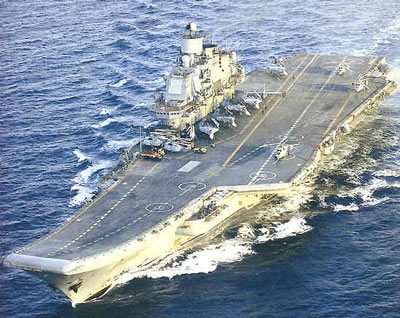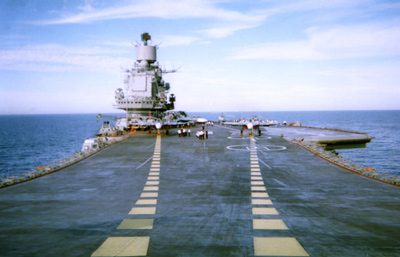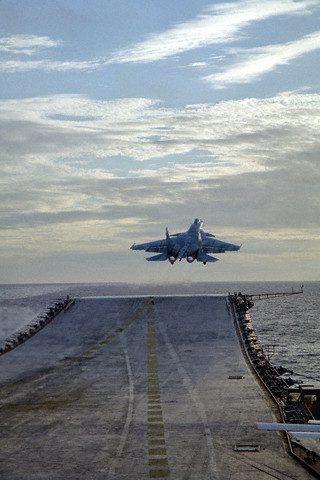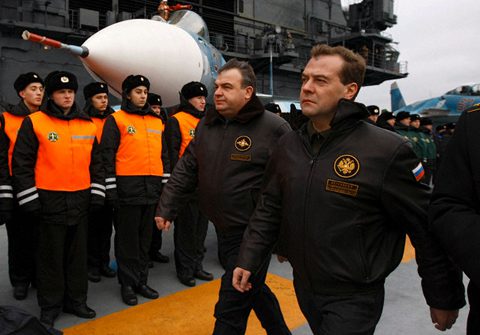Despite being in service for 14 years, the aircraft carrier Admiral Kuznetsov has never officially ceased operations, as it is the only aircraft carrier in the Russian Navy.
The Kuznetsov was constructed at the Nikolayev South Shipyard on the Black Sea in Ukraine. The project began in 1985, but it took a decade before the Kuznetsov was officially commissioned.

Kuznetsov is the only aircraft carrier in the Russian Navy.
The second aircraft carrier was launched in 1988, named Varyag. However, Varyag has never served in the Russian Navy as the vessel belonged to Ukraine during the “divorce” of the Black Sea Fleet (between Russia and Ukraine). Subsequently, Varyag was sold to China because it was deemed unfit for combat.
Flight Deck and Aircraft Systems
The flight deck covers an area of 14,700 m2 and is equipped with two elevators that lift aircraft from the hangar to the flight deck. Unlike other Western aircraft carriers, Kuznetsov does not use a catapult system. Instead, it operates based on a 12-degree ramp at the end of the flight deck to assist aircraft takeoffs.

The aircraft parking area measures 14,700 m2.
Aircraft on board the Kuznetsov take off with light air-to-air missile payloads and leave the deck at speeds exceeding the stall speed (the speed at which an aircraft cannot maintain lift and becomes unbalanced).
The absence of a catapult system has significantly limited the weight of the aircraft types. If a fighter jet carries a full payload, it will not achieve a speed above the stall speed.

Aircraft take off using the 12-degree ramp.
The Kuznetsov is equipped with 17 aircraft (12 Su-33 and 5 Su-25), along with 24 helicopters (4 Kamov Ka-27LD32, 18 Kamov Ka-27PLO, and 2 Kamov Ka-27S).
Attack and Defense Missile Systems
The Kuznetsov is armed with the Granit missile system, featuring 12 ground-to-ground missile launchers. The Granit missile (designated SS-N-19 Shipwreck by NATO) has a range of over 400 km and can carry either a nuclear or conventional warhead.
Furthermore, the Kuznetsov is equipped with the Klinok air defense missile system, consisting of 24 vertically launched missile platforms and 192 missiles, protecting the carrier from anti-ship missiles, fighters, and enemy warships. Each missile launch takes only three seconds, allowing the system to engage four targets simultaneously.
The system’s operational range is between 12 to 15 km. The Kashstan air defense missile system protects the ship from precise weapons such as anti-ship missiles, radar-guided missiles, and fighter aircraft.

Russian President Medvedev inspecting the Kuznetsov.
The Kuznetsov also features the Udav-1 anti-submarine system with 60 missiles. Developed by the Moscow-based Splav Production and Research Association, Udav-1 can protect surface ships by diverting or destroying incoming torpedoes. This system also enables the Kuznetsov to counter submarines and underwater threats. The Udav-1 consists of a total of 10 gun mounts and can launch anti-submarine rockets 111SG, anti-submarine mines 111SZ, and torpedo decoy bombs 111SO.
The radar systems on the Kuznetsov include ground and air target detection radars D/E, search radar F, air traffic control radar G/H, guidance radar I, and four fire control radars K for the Kashstan air defense system.
Key Specifications of Kuznetsov:
Crew: 1,960 personnel (626 crew members, 40 staff), 3,857 cabins.
Length: 306.3 m.
Beam: 72.3 m.
Displacement: 65,000 tons (maximum load).
Speed: 32 knots (59 km/h).
Operational range: 7,130 km at 59 km/h.
Endurance: 45 days.
Propulsion: 8 steam engines (pressure boilers), 4 shafts, 200,000 horsepower; 2 gas turbines with 50,000 hp; 9 gas turbine generators with 2,011 hp; 6 diesel engines with 2,011 hp.




















































